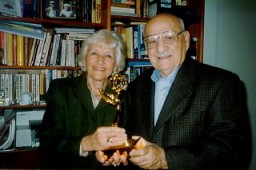<< Previous | Displaying results 2101-2150 of 2604 for "" | Next >>
-
Arriving in Shanghai
PhotoGerman Jewish refugees disembark in the port of Shanghai, one of the few places without visa requirements. Shanghai, China, 1940.
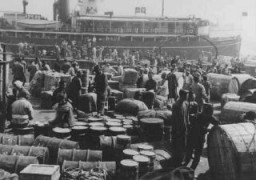
-
Boarding the SS Mouzinho
PhotoJewish refugees board the SS Mouzinho for the voyage to the United States. Among these refugees is a group of Jewish children recently rescued from internment camps in France. Lisbon, Portugal, ca. June 10, 1941.
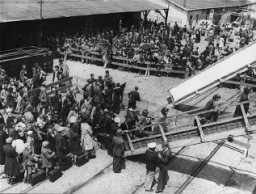
-
Jewish refugee boys at a children's home in France
PhotoJewish refugee boys at the Maison des Pupilles de la Nation children's home in Aspet. These children reached the home through the efforts of the Children's Aid Society (Oeuvre de Secours aux Enfants; OSE) and the American Friends Service Committee. Aspet, France, ca. 1942.

-
Body of a refugee removed from a ship
PhotoPalestine police remove the body of a refugee (draped in a Jewish flag), killed aboard the refugee ship Theodor Herzl during its unsuccessful attempt to run through a British naval blockade. Haifa port, Palestine, April 14, 1947.

-
German documents collected by war crimes investigators
PhotoUS Army staffers organizing stacks of German documents collected by war crimes investigators as evidence for the International Military Tribunal.

-
Opening statement at the International Military Tribunal
PhotoChief US Counsel Justice Robert Jackson delivers the prosecution's opening statement at the International Military Tribunal. Nuremberg, Germany, November 21, 1945.
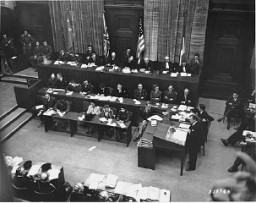
-
The accused and their defense attorneys at Nuremberg
PhotoThe accused and their defense attorneys in the courtroom during the International Military Tribunal. Nuremberg, Germany.
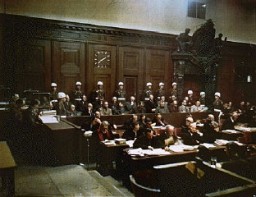
-
Translators at the Nuremberg trial
PhotoEnglish, French, Russian, and German were official languages of the Nuremberg trials. Translators provided simultaneous translations of the proceedings. Here, they route translations through a switchboard to participants in the trial. Nuremberg, Germany, November 1945.

-
Amalie Petranka (later Salsitz)
PhotoAmalie Petranka (later Salsitz) at 22 years of age. She gave this photo to Norman Salsitz shortly after they met. Photograph taken in Stanislawow, Poland, on October 10, 1939.
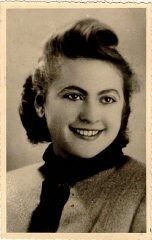
-
Norman Salsitz under an assumed identity
PhotoNorman Salsitz while under the assumed identity Tadeusz Zaleski. Legnica, Poland, 1945.
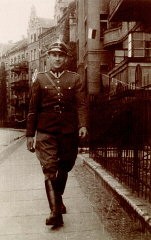
-
Norman Salsitz and Amalie Petranka shortly after they met
PhotoNorman Salsitz and Amalie Petranka shortly after they met (under their assumed identities of, respectively, Felicja Milaszewska and Tadeusz Zaleski). Krakow, Poland, March 15, 1945. With the end of World War II and collapse of the Nazi regime, survivors of the Holocaust faced the daunting task of rebuilding their lives. With little in the way of financial resources and few, if any, surviving family members, most eventually emigrated from Europe to start their lives again. Between 1945 and 1952, more than…

-
Amalie and Norman Salsitz, Brooklyn, New York, 1949
Photo1949 photograph of Amalie and Norman Salsitz in Brooklyn, New York, two years after they came to the United States. With the end of World War II and collapse of the Nazi regime, survivors of the Holocaust faced the daunting task of rebuilding their lives. With little in the way of financial resources and few, if any, surviving family members, most eventually emigrated from Europe to start their lives again. Between 1945 and 1952, more than 80,000 Holocaust survivors immigrated to the United…

-
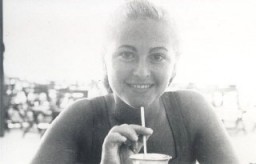
-
Norman Salsitz's daughter
PhotoNorman's daughter, Esther, at age one. April 1957. With the end of World War II and collapse of the Nazi regime, survivors of the Holocaust faced the daunting task of rebuilding their lives. With little in the way of financial resources and few, if any, surviving family members, most eventually emigrated from Europe to start their lives again. Between 1945 and 1952, more than 80,000 Holocaust survivors immigrated to the United States. Norman was one of them.
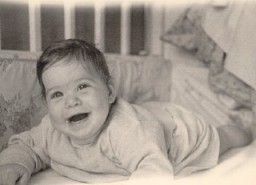
-
Norman Salsitz's wife and daughter
PhotoNorman's daughter, Esther, at three weeks of age, with her mother, Amalie. September 1956. With the end of World War II and collapse of the Nazi regime, survivors of the Holocaust faced the daunting task of rebuilding their lives. With little in the way of financial resources and few, if any, surviving family members, most eventually emigrated from Europe to start their lives again. Between 1945 and 1952, more than 80,000 Holocaust survivors immigrated to the United States. Norman was one of them.
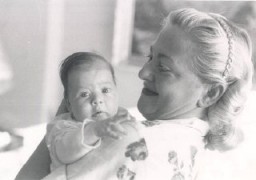
-
Norman Salsitz in the United States
PhotoNorman (with camera) in the United States. August 1948. With the end of World War II and collapse of the Nazi regime, survivors of the Holocaust faced the daunting task of rebuilding their lives. With little in the way of financial resources and few, if any, surviving family members, most eventually emigrated from Europe to start their lives again. Between 1945 and 1952, more than 80,000 Holocaust survivors immigrated to the United States. Norman was one of them.
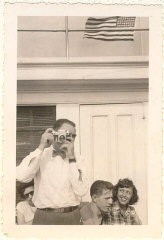
-
Amalie and Norman Salsitz go to Israel
PhotoAmalie and Norman Salsitz go to Israel to visit family members. Lod (Lydda), Israel, February 9, 1949. With the end of World War II and collapse of the Nazi regime, survivors of the Holocaust faced the daunting task of rebuilding their lives. With little in the way of financial resources and few, if any, surviving family members, most eventually emigrated from Europe to start their lives again. Between 1945 and 1952, more than 80,000 Holocaust survivors immigrated to the United States. Norman was one of…
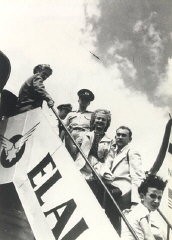
-
Amalie with her grandmother and sister in Tel Aviv
PhotoAmalie (left) with her grandmother and sister Pepka in Tel Aviv, Israel, 1949.
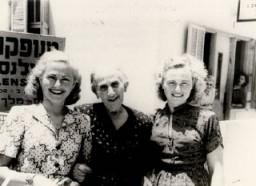
-
Photograph taken at Esther Salsitz's marriage
PhotoPhotograph taken at the marriage of Esther Salsitz and her fiance. Esther's parents, Norman and Amalie, stand at left and right (respectively). June 19, 1977. With the end of World War II and collapse of the Nazi regime, survivors of the Holocaust faced the daunting task of rebuilding their lives. With little in the way of financial resources and few, if any, surviving family members, most eventually emigrated from Europe to start their lives again. Between 1945 and 1952, more than 80,000 Holocaust…

-
Norman and Amalie Salsitz with their first grandchild
PhotoNorman and Amalie Salsitz with their first grandchild, Dustin. March 11, 1983. With the end of World War II and collapse of the Nazi regime, survivors of the Holocaust faced the daunting task of rebuilding their lives. With little in the way of financial resources and few, if any, surviving family members, most eventually emigrated from Europe to start their lives again. Between 1945 and 1952, more than 80,000 Holocaust survivors immigrated to the United States. Norman was one of them.
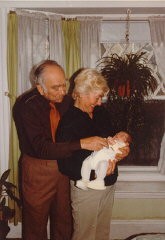
-
Norman Salsitz's grandchildren
PhotoNorman's grandchildren, Dustin, Aaron, and Michael. September 30, 1993. With the end of World War II and collapse of the Nazi regime, survivors of the Holocaust faced the daunting task of rebuilding their lives. With little in the way of financial resources and few, if any, surviving family members, most eventually emigrated from Europe to start their lives again. Between 1945 and 1952, more than 80,000 Holocaust survivors immigrated to the United States. Norman was one of them.
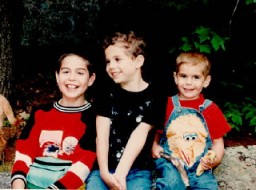
-
Amalie and Norman Salsitz with a copy of their book
PhotoJune 6, 1991, photograph showing Amalie and Norman Salsitz with a copy of their book, Against All Odds. With the end of World War II and collapse of the Nazi regime, survivors of the Holocaust faced the daunting task of rebuilding their lives. With little in the way of financial resources and few, if any, surviving family members, most eventually emigrated from Europe to start their lives again. Between 1945 and 1952, more than 80,000 Holocaust survivors immigrated to the United States. Norman was one of…
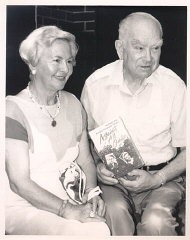
-
Norman Salsitz's grandchildren in 1997
PhotoNorman's grandchildren, Michael, Dustin, and Aaron in 1997. With the end of World War II and collapse of the Nazi regime, survivors of the Holocaust faced the daunting task of rebuilding their lives. With little in the way of financial resources and few, if any, surviving family members, most eventually emigrated from Europe to start their lives again. Between 1945 and 1952, more than 80,000 Holocaust survivors immigrated to the United States. Norman was one of them.
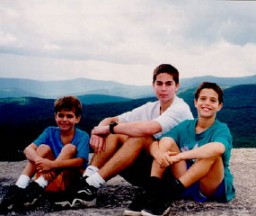
-
Norman Salsitz holds a photograph of himself and Amalie
PhotoNorman Salsitz holds a photograph of himself and Amalie from 1945. 2004. With the end of World War II and collapse of the Nazi regime, survivors of the Holocaust faced the daunting task of rebuilding their lives. With little in the way of financial resources and few, if any, surviving family members, most eventually emigrated from Europe to start their lives again. Between 1945 and 1952, more than 80,000 Holocaust survivors immigrated to the United States. Norman was one of them.
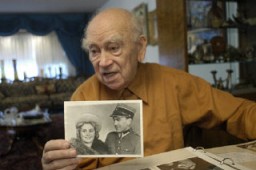
-
Norman Salsitz holds a photograph of his wife and daughter
PhotoNorman Salsitz holds a photograph of his wife, Amalie, and daughter, Esther. 2004. With the end of World War II and collapse of the Nazi regime, survivors of the Holocaust faced the daunting task of rebuilding their lives. With little in the way of financial resources and few, if any, surviving family members, most eventually emigrated from Europe to start their lives again. Between 1945 and 1952, more than 80,000 Holocaust survivors immigrated to the United States. Norman was one of them.
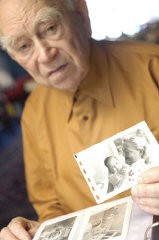
-
2004 portrait of Norman Salsitz
PhotoBorn Naftali Saleschutz, Norman was the youngest of nine children in a devout Hasidic Jewish family. They lived in Kolbuszowa, Poland. In the Hasidic tradition, he wore a long black coat and shoulder-length earlocks. He first faced antisemitism in the second grade when his teacher cut one earlock off each Jewish boy.
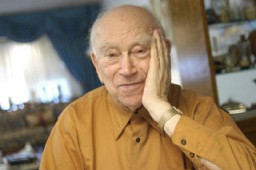
-
Norman Salsitz looking through his photographs
PhotoNorman Salsitz looks through his prewar family photographs. 2004. With the end of World War II and collapse of the Nazi regime, survivors of the Holocaust faced the daunting task of rebuilding their lives. With little in the way of financial resources and few, if any, surviving family members, most eventually emigrated from Europe to start their lives again. Between 1945 and 1952, more than 80,000 Holocaust survivors immigrated to the United States. Norman was one of them.

-
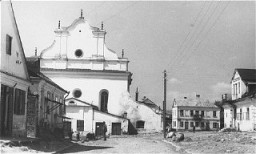
-
Aron Derman while he was with Polish partisans in 1944.
PhotoAron Derman while he was with Polish partisans in 1944. In this photograph, Aron wears a fur hat that he made and boots that he finished himself (he found them in the ghetto, unfinished, and sewed them up). Lisa Nussbaum was also a member of the partisans. Aron recounted that for a short while, Lisa was in charge of 200 women. Photograph taken in 1944, in a partisan base in the Naroch forest.
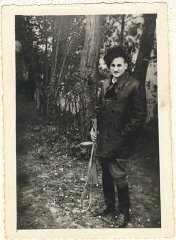
-
Aron in Budapest, 1945
PhotoAron in Budapest, 1945, while en route from Poland to Italy with Brihah, moving to Palestine. In Aron's words: "We got connected with the Brihah in Poland, got directions to go to Bratislava and on to Budapest. On our trip, we didn't know where we going from city to city, only our final destination." July 5, 1945, Budapest, Hungary.

-
Portrait of Aron's family on his mother's side
PhotoPortrait of Aron's family on his mother's side, taken when Aron's cousin moved to Israel in 1933-1934. Aron is seated second from left, bottom row. His mother, Miriam, is in the center row, second from right. Aron's father is behind her and to her right. Aron himself was 8 or 9 years old when this picture was taken in either May or June. At the time, Aron recalled, "I was thinking about going to summer camp." Slonim, Poland, 1933-1934.
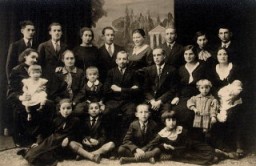
-
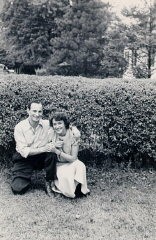
-
Lisa Nussbaum Derman and her family
PhotoLisa Nussbaum and her family. From left to right: Pola (sister), Herschel (father), Borushek (brother) Gittel (mother), and Lisa (about 13 years old in this photograph). Lisa's father exported geese to Germany for a living. Photograph taken in Raczki, Poland, ca. 1939. With the end of World War II and collapse of the Nazi regime, survivors of the Holocaust faced the daunting task of rebuilding their lives. With little in the way of financial resources and few, if any, surviving family members, most…
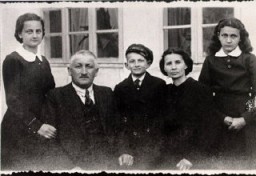
-
Tadek Soroka (right)
PhotoTadek Soroka (right), a Pole who helped Aron and Lisa escape from Poland. This photograph was sent to the Dermans after the war. Date and place unknown.
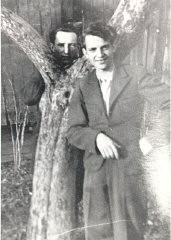
-

-
Aron and Lisa when they came to America
PhotoAron and Lisa when they came to America. Photograph probably taken in Chicago, Illinois, 1947.
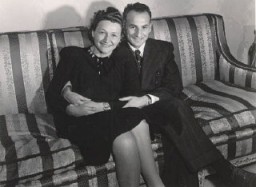
-
Lisa wearing the first suit she bought in America
PhotoLisa wearing the first suit she bought in America (Aron recollected that it was taupe). Lisa's aunt, Faye Abrams, gave her the money to buy this suit. Photograph taken in 1947 in Chicago, Illinois, at the Illinois Central station, 75th street (Lisa was either coming or going from downtown).
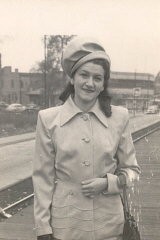
-

-
Aron and Lisa's firstborn child
PhotoAron and Lisa's firstborn child, Howard. Chicago, Illinois, 1949.
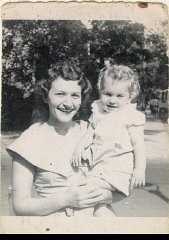
-
Aron and Lisa's three sons
PhotoAron and Lisa's three sons (Howard, Gordon, and Daniel) at the middle son's graduation from the University of Wisconsin. Madison, Wisconsin, ca. 1972.
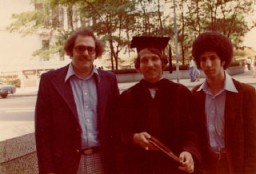
-
Aron in Howard's men's clothing store
PhotoAron standing in Howard's men's clothing store (named for his eldest son) at 9125 Commercial Avenue in Chicago. He opened the store in 1949 and owned it for 30 years. Chicago, Illinois, early 1970s.
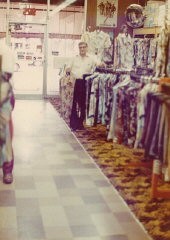
-
Aron standing in Howard's men's clothing store
PhotoAron standing in Howard's men's clothing store (named for his eldest son) at 9125 Commercial Avenue in Chicago. He opened the store in 1949 and owned it for 30 years. Chicago, Illinois, early 1970s.

-
Aron in Teaneck, New Jersey, in the early 1970s
PhotoAron in Teaneck, New Jersey, in the early 1970s. This photograph was taken by Hyman Alpert, known as "Trigger." Alpert, a cousin of Aron's, was a musician with the Glenn Miller Orchestra. Alpert went on to become a photographer in Teaneck.
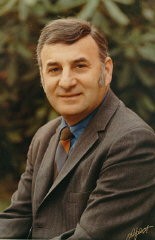
-
Aron and Lisa with Tadek Soroka
PhotoAron and Lisa with Tadek Soroka, the Pole who helped them escape, on the occasion of Soroka's recognition as a "Righteous among the nations" by Yad Vashem. Jerusalem, Israel, 1983.
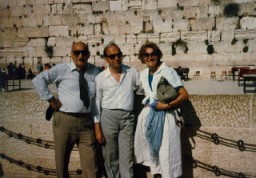
-
Lisa and Aron (center) with their three sons
PhotoLisa and Aron (center) with their three sons, Gordon, Howard, and Daniel. Photograph probably taken in Chicago, Illinois, in 1990.
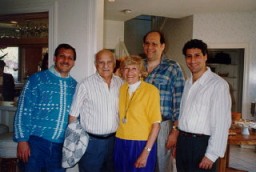
-
Granddaughters of Aron and Lisa Derman
Photo1991 photograph of Aron and Lisa's granddaughters, Courtney and Lindsay. The eldest, Courtney, graduated from Harvard Business School in 2004.
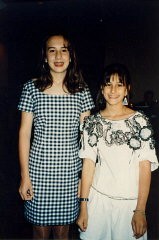
-
The extended Derman family
PhotoThe extended Derman family. Top row, left to right: Aron, Lisa, Howard, Miriam, Daniel, Ari, Gordon, and Barbara (Howie's wife). Front row, left to right: Rachel, Yali, Evan, Gabe, Courtney, Ben, and Lindsay.
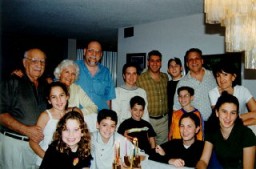
-
Aron and Lisa accompanying high school students to Poland
PhotoAron and Lisa in Poland, ca. 1994, while accompanying high school students as part of a "Shoreshim" group.

-
Lisa and Aron with Chicago Mayor Richard Daley on Holocaust Remembrance Day.
PhotoLisa and Aron with Chicago Mayor Richard Daley on Holocaust Remembrance Day. Chicago, Illinois, 1994 or 1995.
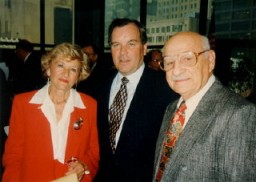
-
Aron and Lisa with their Emmy
PhotoAron and Lisa with the Emmy they won for their 1997 documentary, A Journey of Remembrance. Photograph taken in Northbrook, Illinois, 1998.
